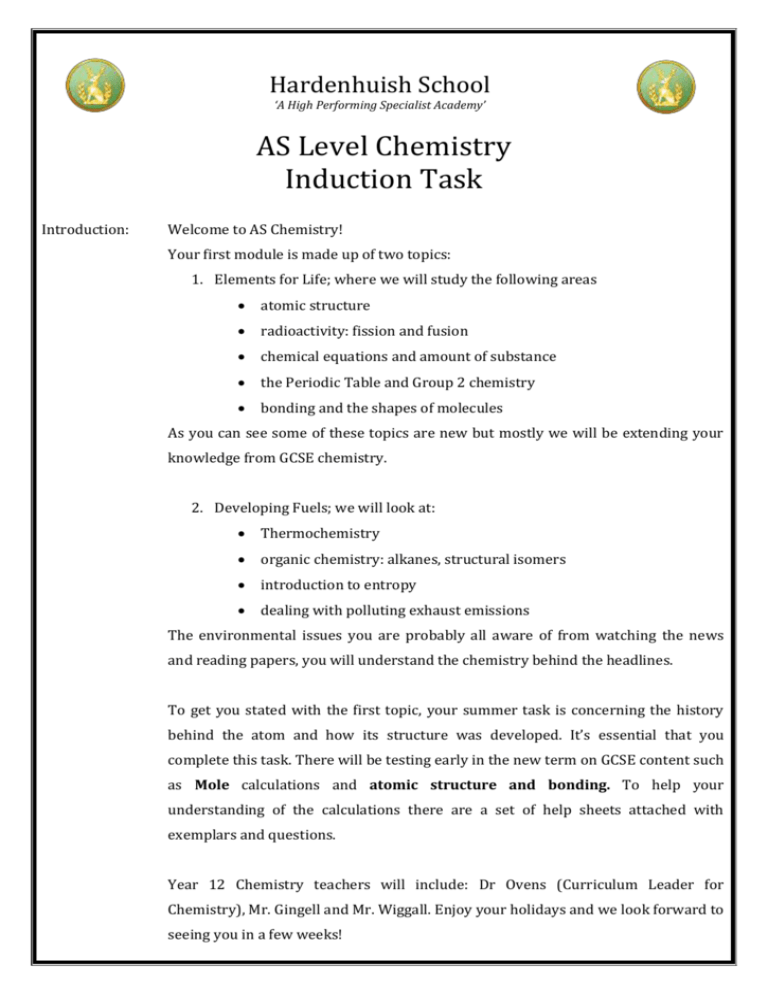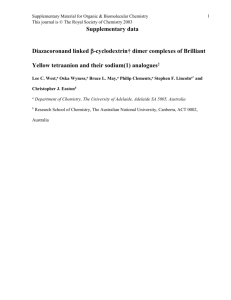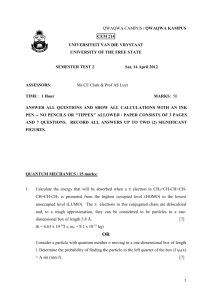Hardenhuish School `A High Performing Specialist Academy` AS
advertisement

Hardenhuish School ‘A High Performing Specialist Academy’ AS Level Chemistry Induction Task Introduction: Welcome to AS Chemistry! Your first module is made up of two topics: 1. Elements for Life; where we will study the following areas atomic structure radioactivity: fission and fusion chemical equations and amount of substance the Periodic Table and Group 2 chemistry bonding and the shapes of molecules As you can see some of these topics are new but mostly we will be extending your knowledge from GCSE chemistry. 2. Developing Fuels; we will look at: Thermochemistry organic chemistry: alkanes, structural isomers introduction to entropy dealing with polluting exhaust emissions The environmental issues you are probably all aware of from watching the news and reading papers, you will understand the chemistry behind the headlines. To get you stated with the first topic, your summer task is concerning the history behind the atom and how its structure was developed. It’s essential that you complete this task. There will be testing early in the new term on GCSE content such as Mole calculations and atomic structure and bonding. To help your understanding of the calculations there are a set of help sheets attached with exemplars and questions. Year 12 Chemistry teachers will include: Dr Ovens (Curriculum Leader for Chemistry), Mr. Gingell and Mr. Wiggall. Enjoy your holidays and we look forward to seeing you in a few weeks! Task: Research on the following scientists and produce a poster or leaflet on… …Who were they, what did we think the atom looked like before, what was their experiment, what did they expect to see and what did they actually see? What did they think the atom looked like after they’ve made their discoveries? Ernest Rutherford Joseph John Thompson Niels Bohr John Dalton James Chadwick Additional: Help sheets: Moles helpsheet Useful Websites: http://www.bbc.co.uk/bitesize/higher/ http://www.4college.co.uk/as/index.php Due: To be handed in to your teacher at the start of your first chemistry lesson in September Set by: If you have any queries regarding the task set please contact Chemistry teacher Mr. Gingell email to: pjg@hardenhuish.wilts.sch.uk Expected Time 2-3 hours Commitment: Moles The Mole The standard unit of amount of a substance The number of particles in a mole is known as Avagadro’s Constant (L) Avagadro’s Constant has a value of 6.023x1023 mol-1 Example: If one atom has a mass of 1.234x10 -23g Then on mole of atoms will have a mass of 1.234x10 -23g x 6.023x1023 = 7.432g Q1. Calculate the mass of one mole of carbon-12 atoms. [mass of 1 proton = 1.672x10-24g, mass of 1 neutron = 1.674x10-24g, mass of 1 electron = 9.109x10-28] Mole Calculations Substances mass Molar mass g g mol-1 or or kg kg mol-1 Example: Calculate the number of moles of oxygen molecules in 4g Oxygen molecules have the formula O2, therefore the relative mass will be 16 x 2= 32 g mol-1 Moles = mass / molar mass = 4g / 32 g mol-1 = 0.125 mol Q2. a) Calculate the number of moles in o 10g of Ca atoms o 10g of CaCO3 o 36g of water molecules o 4g of hydrogen atoms b) Calculate the mass of o 2 mol of CH4 o 0.5 mol of NaNO3 o 6 mol of nitrogen atoms o 6 mol of nitrogen molecules Solutions n = number of mol c = concentration v = volume (convert dm3) Molarity/Concentration Volume mol dm-3 dm3 or cm3 Example 1: Calcuate the number of mol of sodium hydroxide in 25cm3 of 2mol dm-3 NaOH Mol = concentration x volume (in cm3) 1000 dm-3 = 2mol = 0.05 mol x 1000 25 Example 2: 4.25g of Na2CO3 are dissolved in water and the solution made upto 250cm 3. What is the concentration of the solution in mol dm-3? Concentration= molar mass: no. of mol in 250 cm3: no. of mol in 1000cm3 106g mol-1 4.25g / 106 g mol-1 0.04 x 4 = 0.04 mol = 0.16 mol dm-3 Q3. Calculate the number of mol in o o o o 1 dm3 of 2mol dm-3NaOH 5 dm3 of 0.1mol dm-3 HCl 250cm3 of 2mol dm-3NaOH 25cm3 of 0.2mol dm-3H2SO4 Empirical formulae and molecular formulae Description Expresses the elements in a simple ratio (e.g. CH2) It can sometimes be the same as the molecular formula (e.g. H2O) Calculations You are essentially using m = n x M You will use; -Actual mass; in grams or percentage for each element in the molecule. - Relative atomic masses of each element Example Calculate the empirical formula of a compound containing 48% carbon,4% hydrogen and 48% oxygen Set out as a table; atoms as headings. Write mass (g/%) Divide by Ar This is the molar ratio Ensure all numbers are whole (divide all by smallest number, may need to multiply up too) Express as a formula C 48 12 4 n/a H 4 1 4 n/a O 48 16 3 n/a C4H4O3 Q4. Calculate the empirical formula of a compound containing 1.8g carbon, 0.48g oxygen and 0.3g hydrogen. Molecular formula Description Exact number of atoms of each element in the formula Calculations compare the empirical formula with the relative molecular mass, Mr. The Mr will be an exact multiple of the empirical formula mass. Example Calculate the molecular formula of a compound of empirical formulaCH 2and Mr 84. Mass of CH2 unit Divide Mr (84) by 14 Molecular formula = empirical formula x 6 = 14 =6 = C6H12











